Rapid and Easy Assessment of Friction and Load-Bearing Capacity in Thin Coatings
Abstract
:1. Introduction
2. Materials and Methods
2.1. Materials
2.2. Tribological Testing
2.2.1. Measuring Friction through Energy Dissipated in Vibratory Systems
2.2.2. Sliding Indentation Test
3. Results and Discussion
3.1. Determination of Friction through Energy Dissipated in Vibratory Systems
3.2. Determination of the Load-Bearing Capacity through the Sliding Indentation Test
4. Conclusions
- The proposed test method to measure friction, based on free vibration movement, allowed to achieve accurate results very quickly and with samples of simple geometry.
- The sliding indentation technique with a single passage allows the characterization of the maximum load bearing without damage.
- In addition, sliding indentation with multiple passage, in the same track, allows to apprize the endurance performance of the different coatings.
- DLC coatings showed lower friction following TiSiN and Cr coatings. The following relationship was determined: µDLC <µTiSiN <µCr.
- The Young’s modulus given results on a similar rank.
- A great influence of the counter-body was observed. The tribological pairs for those who used the Al2O3 sphere always evidenced lower friction than the pairs for those who used a 100Cr6 sphere, for both tests. Funding: this research received no external funding.
Author Contributions
Funding
Data Availability Statement
Acknowledgments
Conflicts of Interest
References
- Huang, Z.P.; Sun, Y.; Bell, T. Friction behaviour of TiN, CrN and (TiAl)N coatings. Wear 1994, 173, 13–20. [Google Scholar] [CrossRef]
- Holmberg, K.; Siilasto, R.; Laitinen, T.; Andersson, P.; Jäsberg, A. Global energy consumption due to friction in paper machines. Tribol. Int. 2013, 62, 58–77. [Google Scholar] [CrossRef]
- Holmberg, K.; Kivikytö-Reponen, P.; Härkisaari, P.; Valtonen, K.; Erdemir, A. Global energy consumption due to friction and wear in the mining industry. Tribol. Int. 2017, 115, 116–139. [Google Scholar] [CrossRef]
- Holmberg, K.; Erdemir, A. Influence of tribology on global energy consumption, costs and emissions. Friction 2017, 5, 263–284. [Google Scholar] [CrossRef]
- Michailidis, N. Variations in the cutting performance of PVD-coated tools in milling Ti6Al4V, explained through temperature-dependent coating properties. Surf. Coat. Technol. 2016, 304, 325–329. [Google Scholar] [CrossRef]
- Silva, F.; Martinho, R.; Andrade, M.; Baptista, A.; Alexandre, R. Improving the wear resistance of moulds for the injection of glass fibre–reinforced plastics using PVD coatings: A comparative study. Coatings 2017, 7, 28. [Google Scholar] [CrossRef] [Green Version]
- Holmberg, K.; Ronkainen, H.; Matthews, A. Tribology of thin coatings. Ceram. Int. 2000, 26, 787–795. [Google Scholar] [CrossRef]
- Bellardita, M.; Di Paola, A.; Yurdakal, S.; Palmisano, L. Preparation of Catalysts and Photocatalysts Used for Similar Processes. In Heterogeneous Photocatalysis: Relationships with Heterogeneous Catalysis and Perspectives; Marcí, G., Palmisano, L., Eds.; Springer: Berlin/Heidelberg, Germany, 2019; pp. 105–110. [Google Scholar]
- Cardoso, F.J.G. Desempenho de revestimentos de carbono tipo-diamante (produzidos pela tecnologia inovadora Ne-HIPIMS) sob diferentes regimes de lubrificação. Master’s Thesis, Universidade de Coimbra, Coimbra, Portugal, 2013. Unpublished. [Google Scholar]
- Hughes, M. What is HIPIMS? High Power Impulse Magnetron Sputtering. Semicore. 28 October 2016. Available online: http://www.semicore.com/news/93-what-is-hipims (accessed on 1 October 2021).
- Kouznetsov, V.; Macak, K.; Schneider, J.M.; Helmersson, U.; Petrov, I. A novel pulsed magnetron sputter technique utilizing very high target power densities. Surf. Coat. Technol. 1999, 122, 290–293. [Google Scholar] [CrossRef]
- Ferreira, E.S. Pulverização catódica magnetrão com impulsos de alta potência (HiiPIMS) em modo DOMS. Master’s Thesis, Universidade de Coimbra, Coimbra, Portugal, 2020. Unpublished. [Google Scholar]
- Sarakinos, K.; Alami, J.; Konstantinidis, S. High power pulsed magnetron sputtering: A review on scientific and engineering state of the art. Surf. Coat. Technol. 2010, 204, 1661–1684. [Google Scholar] [CrossRef]
- Robertson, J. Diamond-like amorphous carbon. Mater. Sci. Eng. R Rep. 2002, 37, 129–281. [Google Scholar] [CrossRef] [Green Version]
- Erdemir, A.; Bindal, C.; Pagan, J.; Wilbur, P. Characterization of transfer layers on steel surfaces sliding against diamond-like hydrocarbon films in dry nitrogen. Surf. Coat. Technol. 1995, 76, 559–563. [Google Scholar] [CrossRef]
- Grill, A. Tribology of diamondlike carbon and related materials: An updated review. Surf. Coat. Technol. 1997, 94, 507–513. [Google Scholar] [CrossRef]
- Yazdi, M.A.; Lomello, F.; Wang, J.; Sanchette, F.; Dong, Z.; White, T.; Wouters, Y.; Schuster, F.; Billard, A. Properties of TiSiN coatings deposited by hybrid HiPIMS and pulsed-DC magnetron co-sputtering. Vacuum 2014, 109, 43–51. [Google Scholar] [CrossRef]
- Vaz, F.; Rebouta, L.; Goudeau, P.; Girardeau, T.; Pacaud, J.; Riviere, J.P.; Traverse, A. Structural transitions in hard Si-based TiN coatings: The effect of bias voltage and temperature. Surf. Coat. Technol. 2001, 146, 274–279. [Google Scholar] [CrossRef]
- Vepřek, S.; Reiprich, S. A concept for the design of novel superhard coat-ings. Thin Solid Film. 1995, 268, 64–71. [Google Scholar] [CrossRef]
- Kubart, T.; Aijaz, A.; Andersson, J.; Ferreira, F.; Oliveira, J.C.; Sobetkii, A.; Parau, A.C.; Vitelaru, C. High power impulse magnetron sputtering of diamond-like carbon coatings. J. Vac. Sci. Technol. A Vac. Surf. Film. 2020, 38, 043408. [Google Scholar] [CrossRef]
- Ian Hutchings, Philip Shipway, Tribology: Friction and Wear of Engineering Materials, 2nd ed.; Elsevier: Amsterdam, The Netherlands, 2016.
- Wang, C.T.; Hakala, T.J.; Laukkanen, A.; Ronkainen, H.; Holmberg, K.; Gao, N.; Wood, R.J.; Langdon, T.G. Langdon. An investigation into the effect of substrate on the load-bearing capacity of thin hard coatings. J. Mater. Sci. 2016, 51, 4390–4398. [Google Scholar] [CrossRef]
- Carvalho, A.L.; Vilhena, L.M.; Ramalho, A. Study of the frictional behavior of soft contact lenses by an innovative method. Tribol. Int. 2021, 153, 106633. [Google Scholar] [CrossRef]
- Carneiro, E.R.; Coelho, A.S.; Amaro, I.; Paula, A.B.; Marto, C.M.; Saraiva, J.; Ferreira, M.M.; Vilhena, L.; Ramalho, A.; Carrilho, E. Mechanical and Tribological Characterization of a Bioactive Composite Resin. Appl. Sci. 2021, 11, 8256. [Google Scholar] [CrossRef]
- Rigaud, E.; Perret-Liaudet, J.; Belin, M.; Joly-Pottuz, L.; Martin, J.M. An original dynamic tribotest to discriminate friction and viscous damping. Tribol. Int. 2010, 43, 320–329. [Google Scholar] [CrossRef] [Green Version]
- Le Bot, A.; Scheibert, J.; Vasko, A.A.; Braun, O.M. Relaxation tribometry: A generic method to identify the nature of contact forces. Tribol. Lett. 2019, 67, 53. [Google Scholar] [CrossRef] [Green Version]
- Feng, J.L.; Qin, Y. Load bearing capacity investigation and coating failure mechanism for coated spur gears. Appl. Mech. Mater. 2014, 446, 491–496. [Google Scholar] [CrossRef]
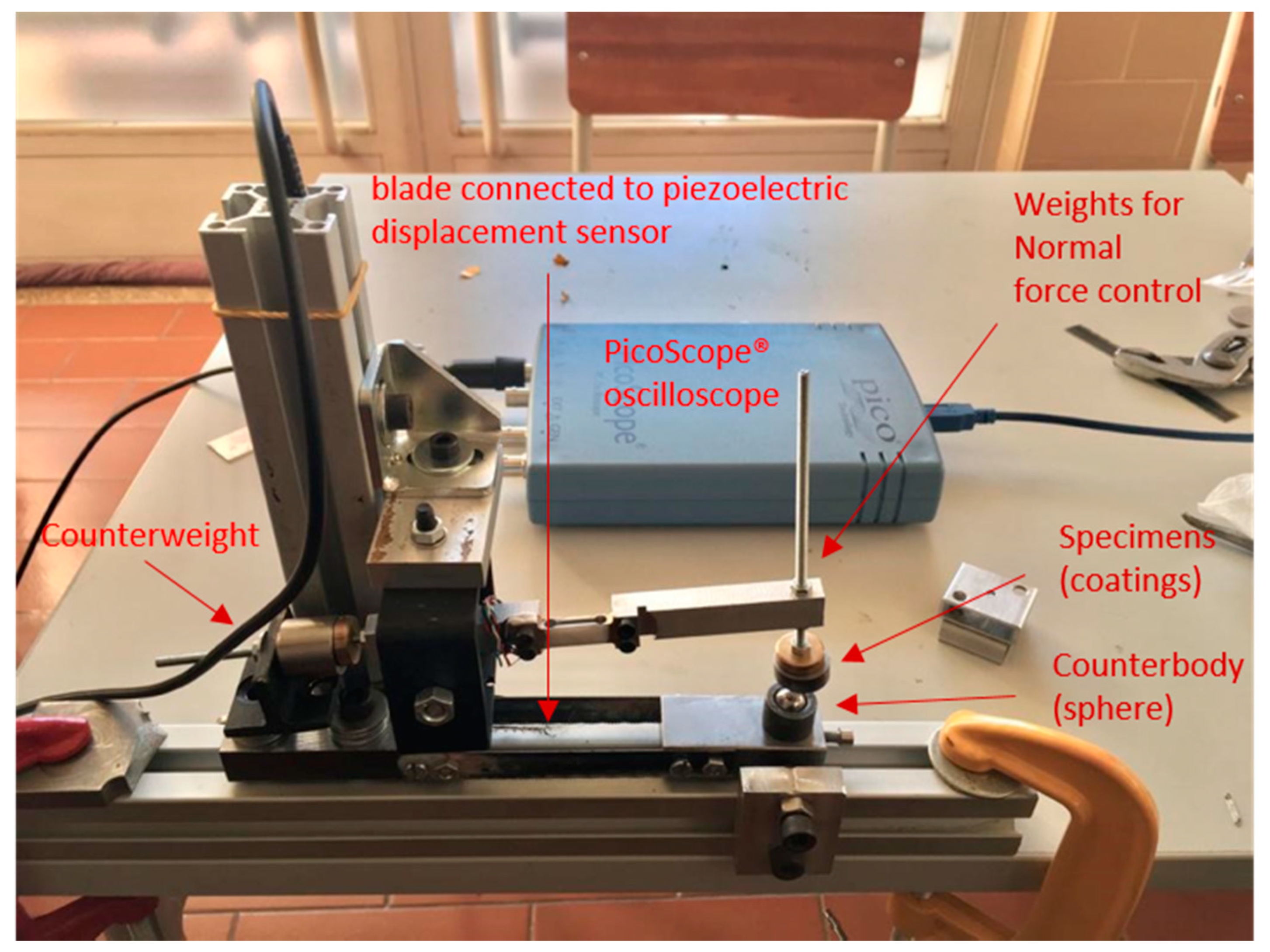
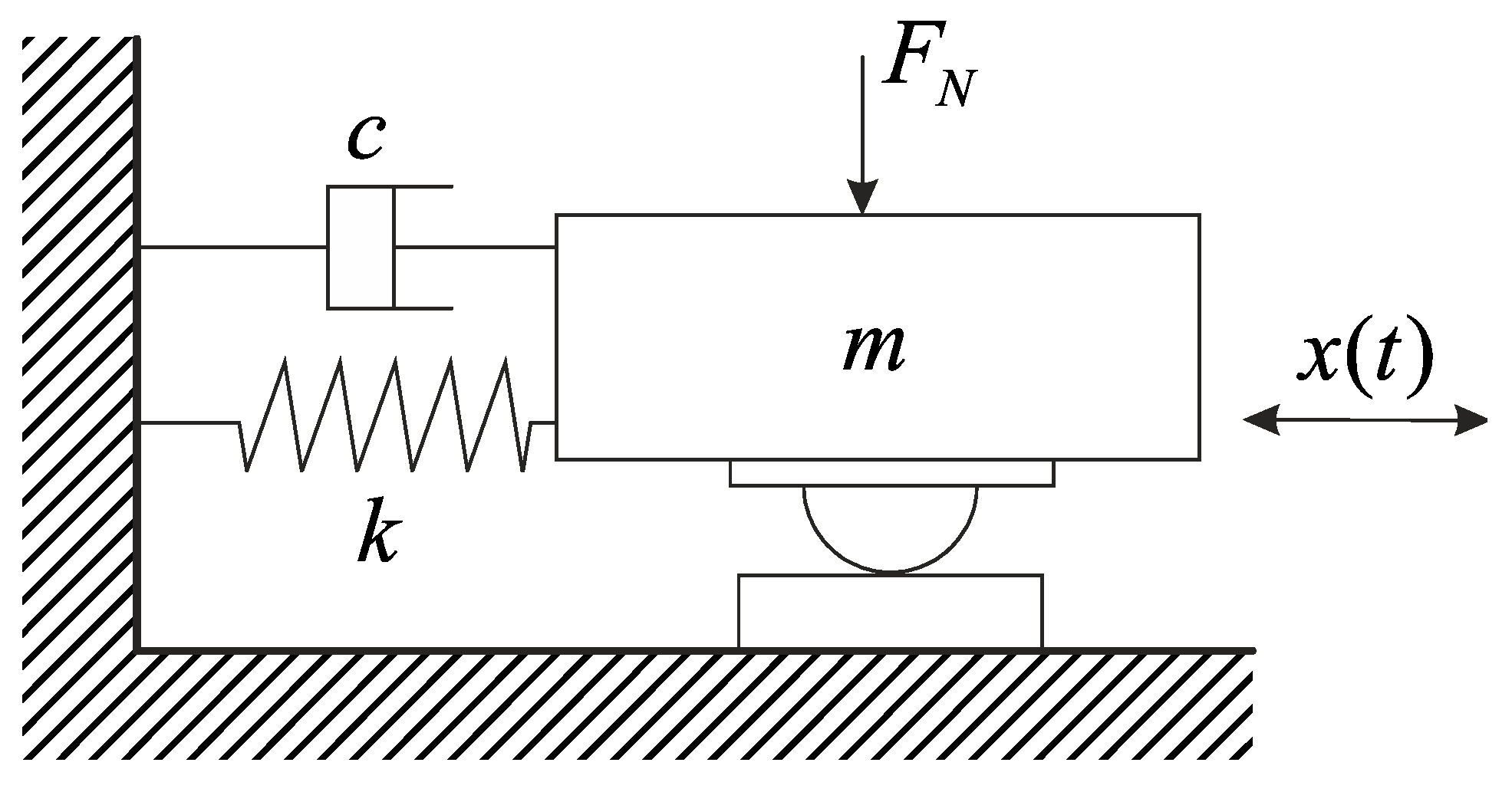

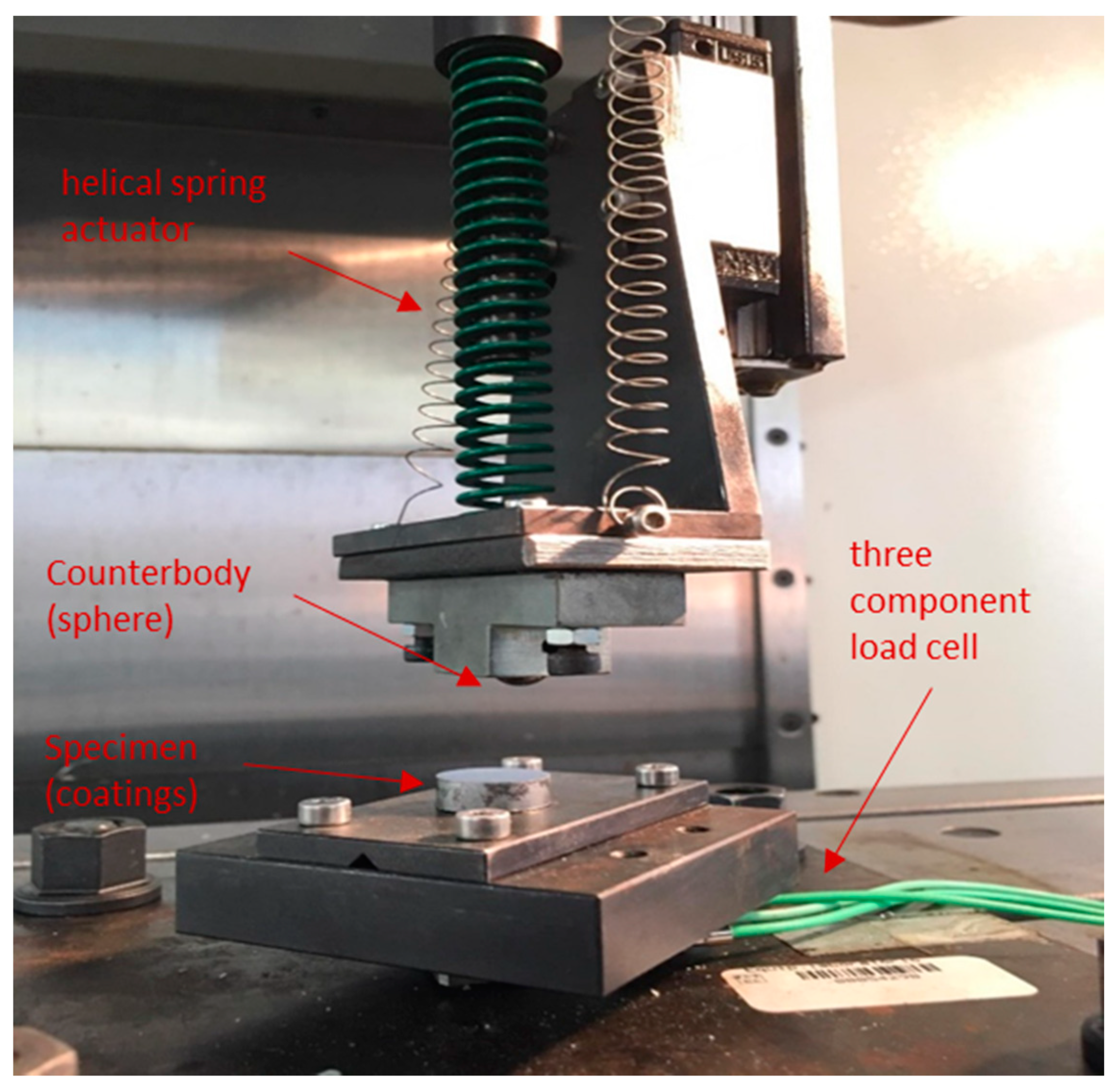

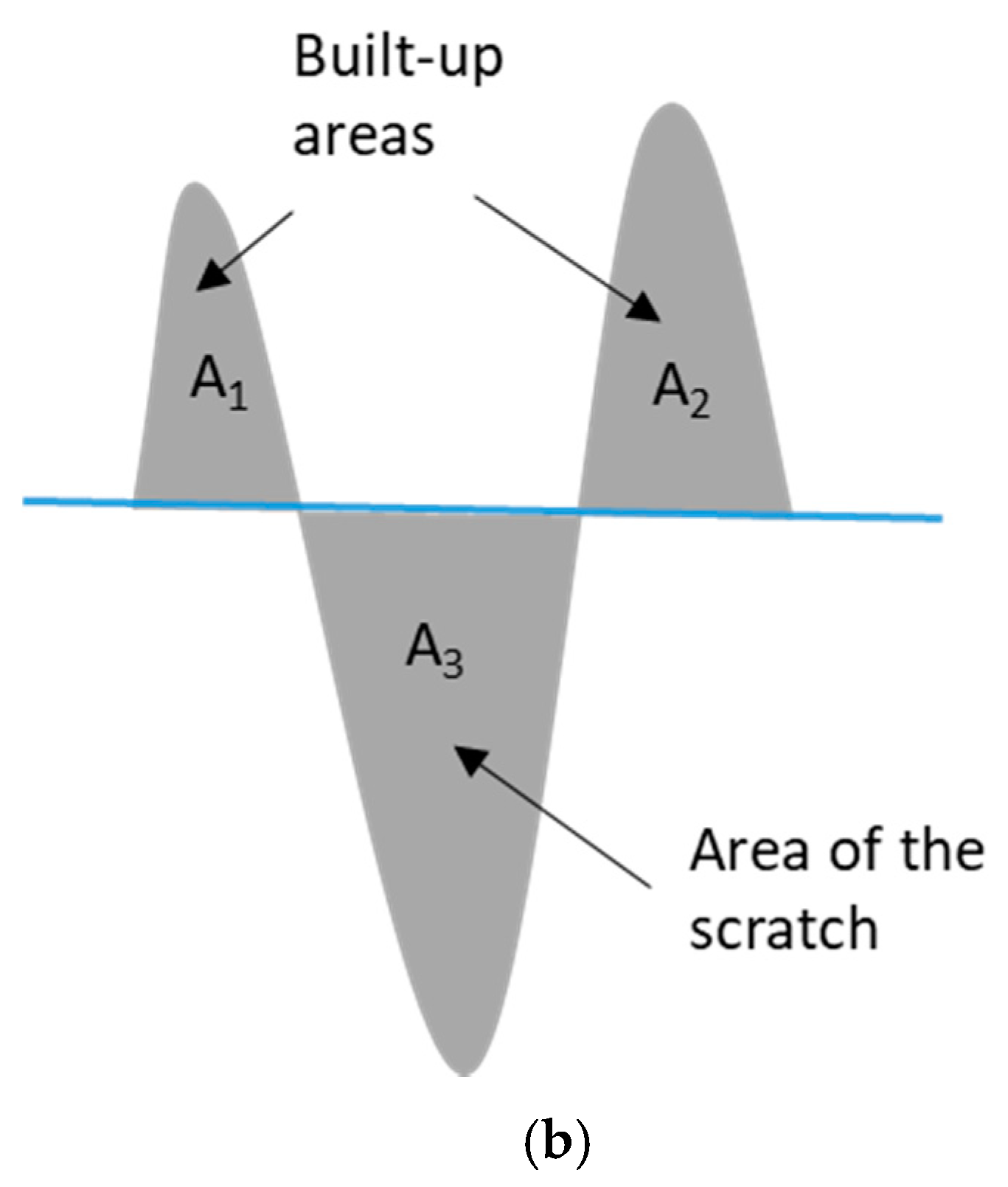
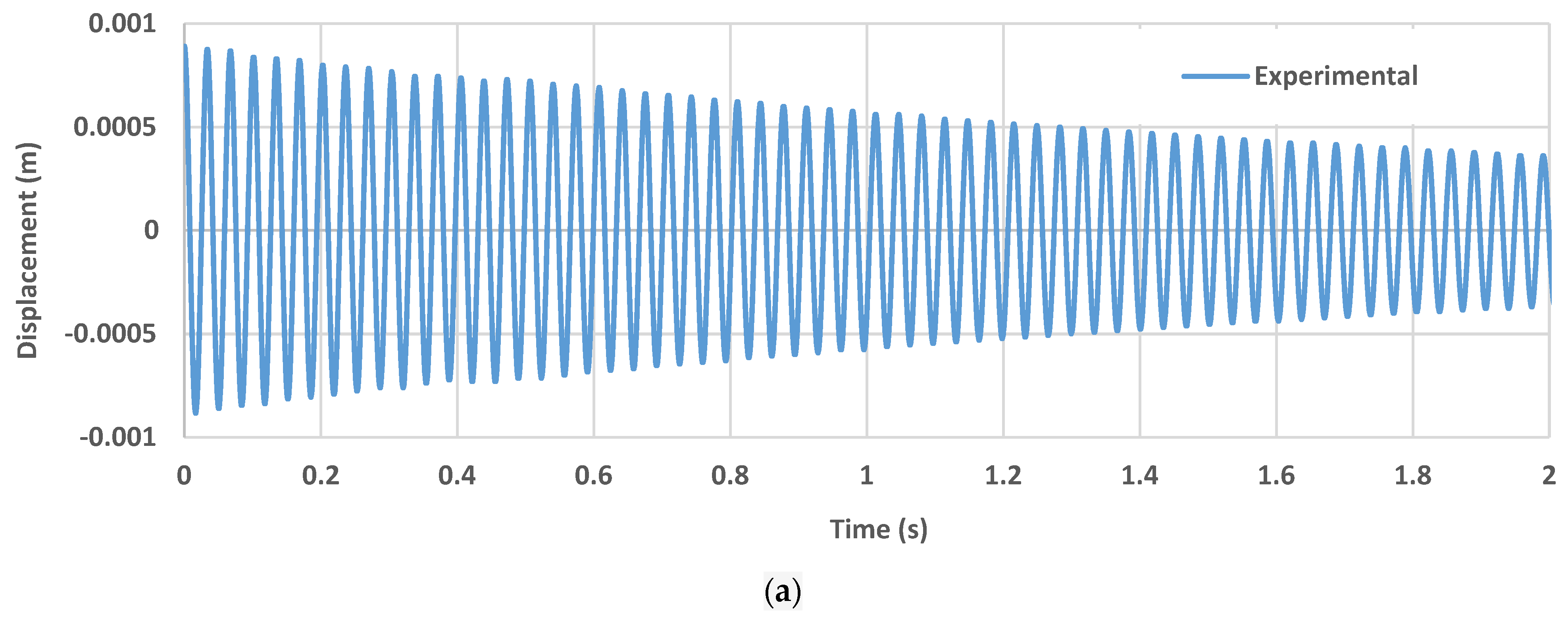
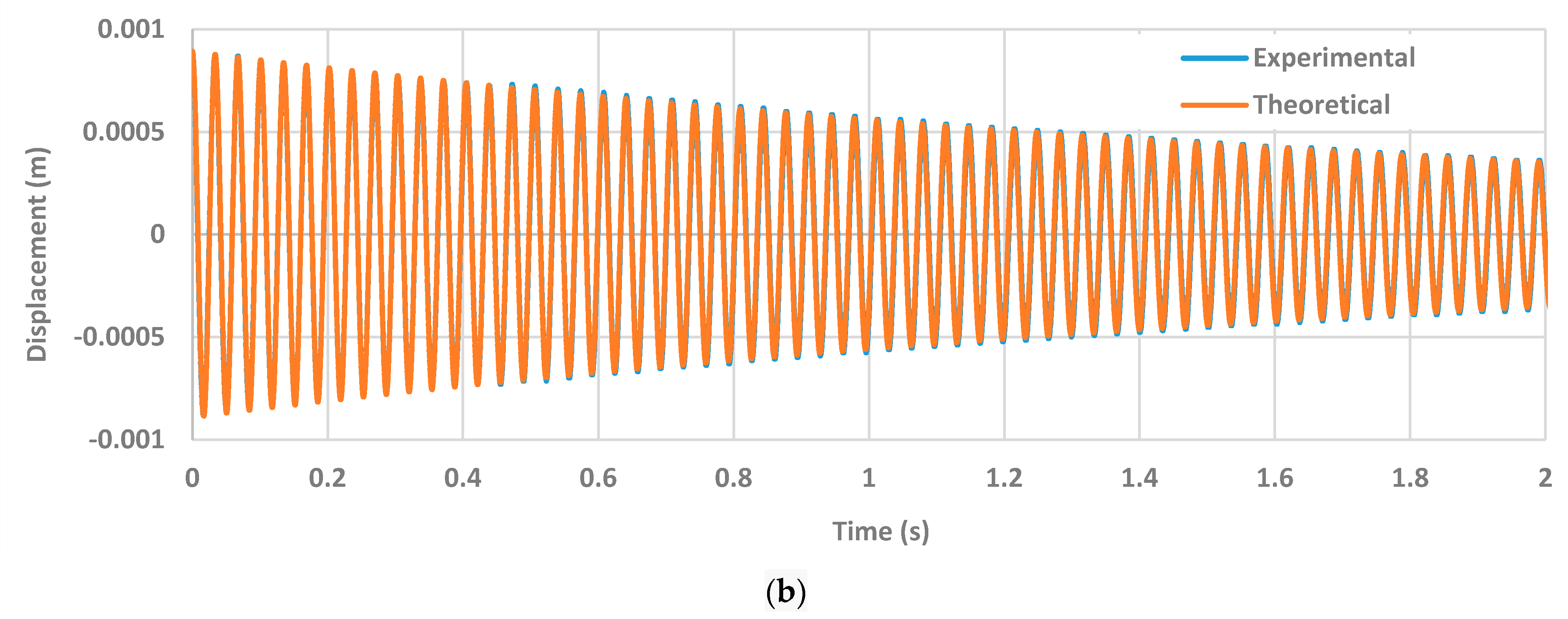
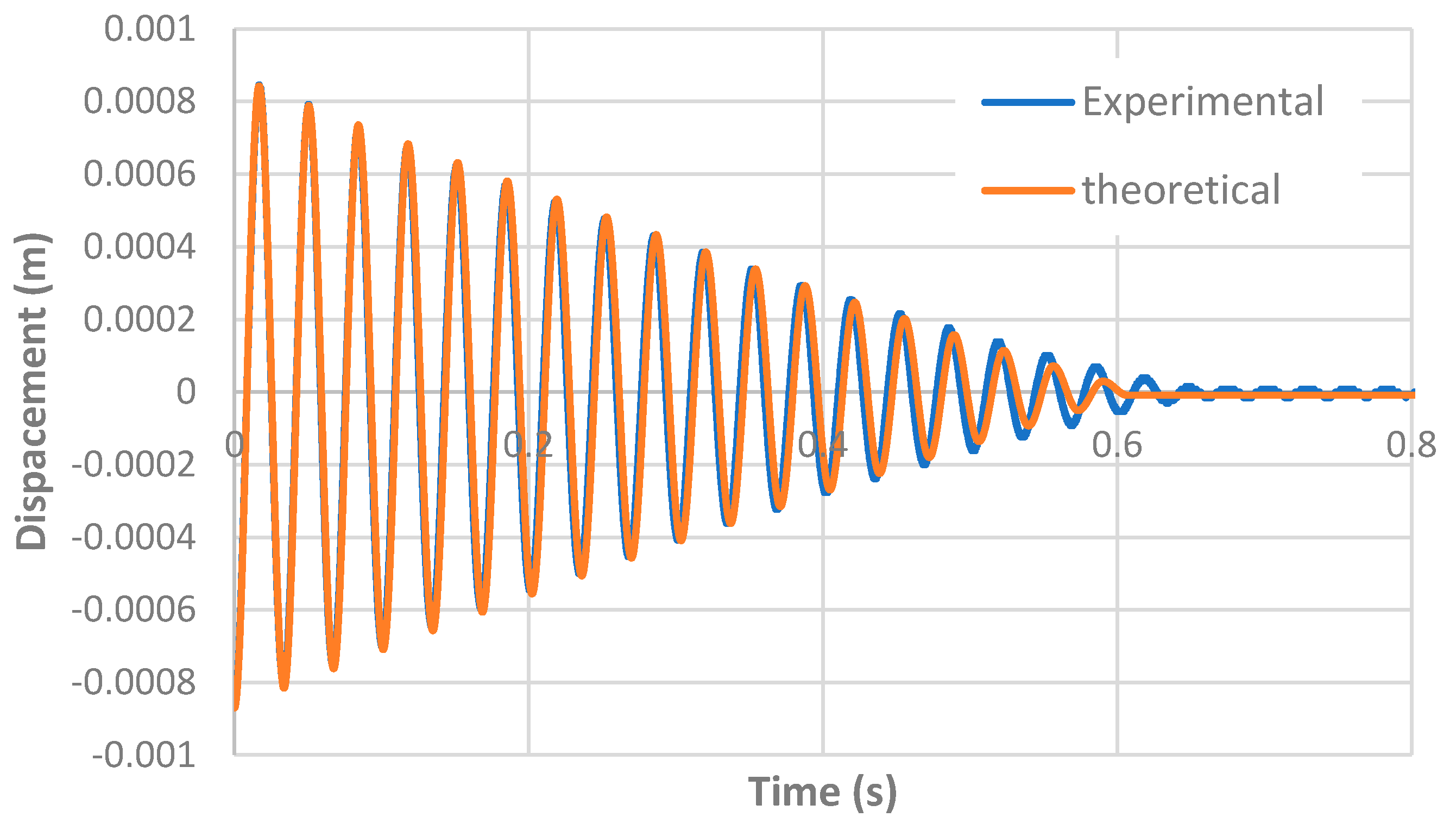
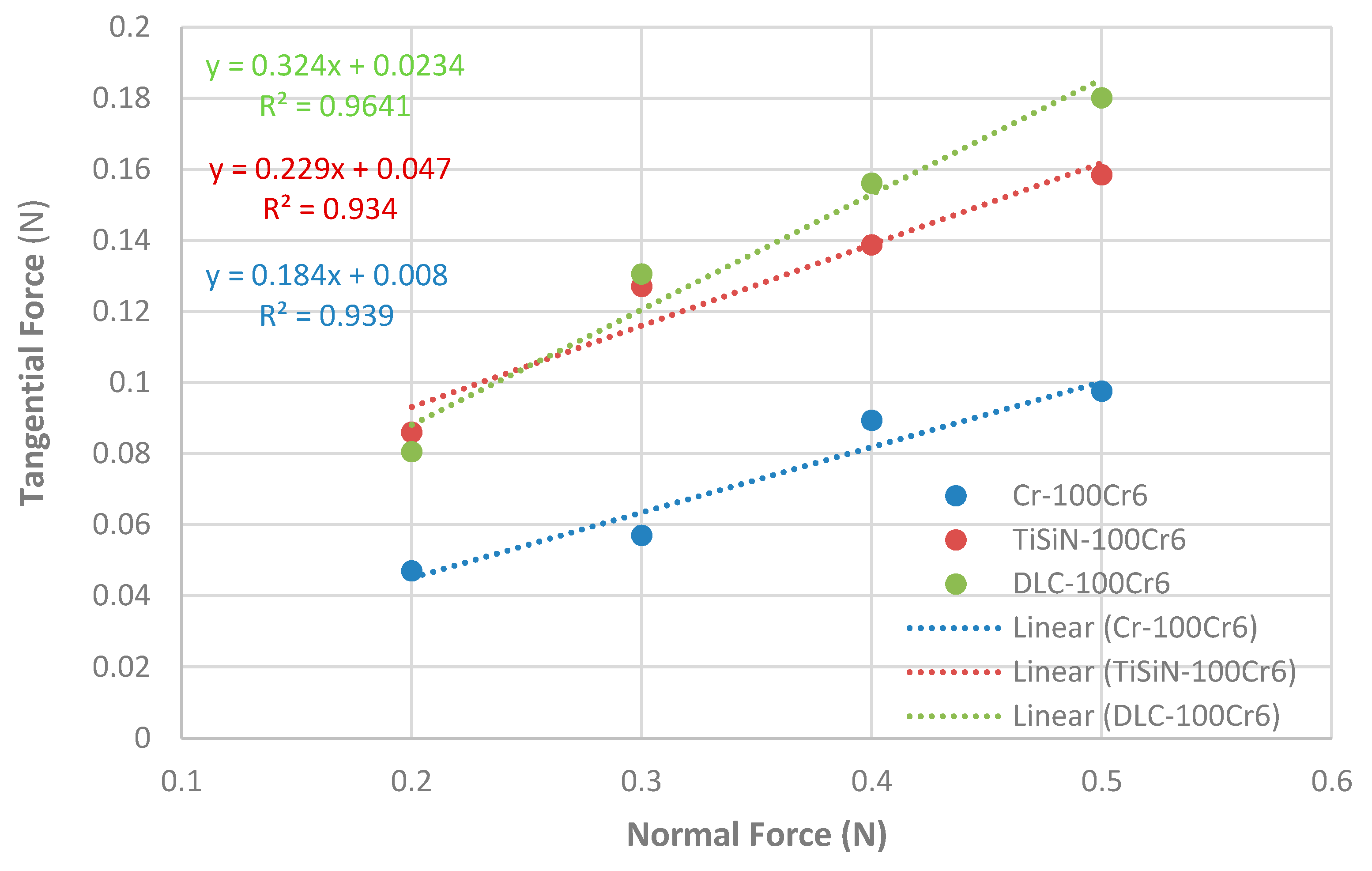
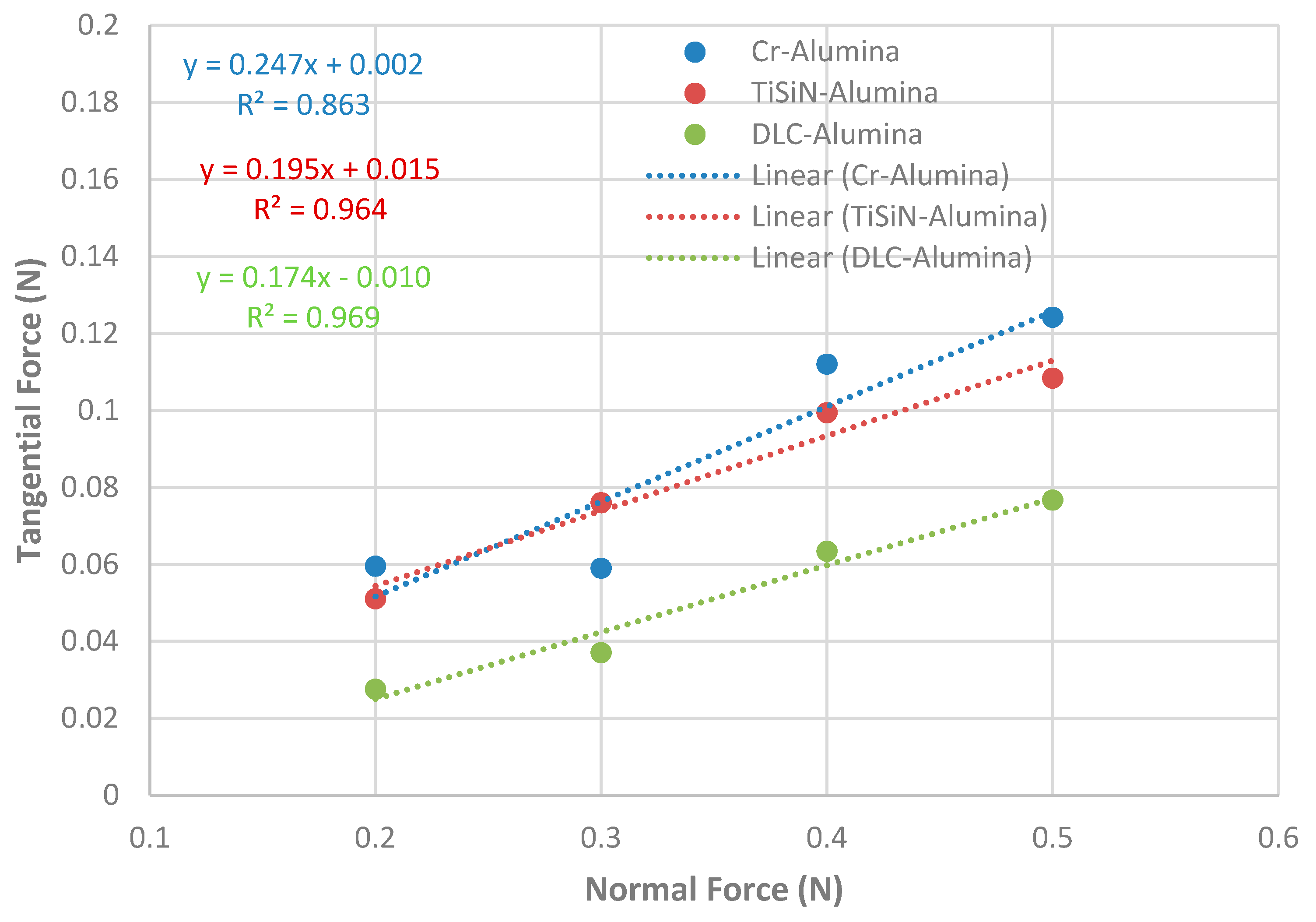
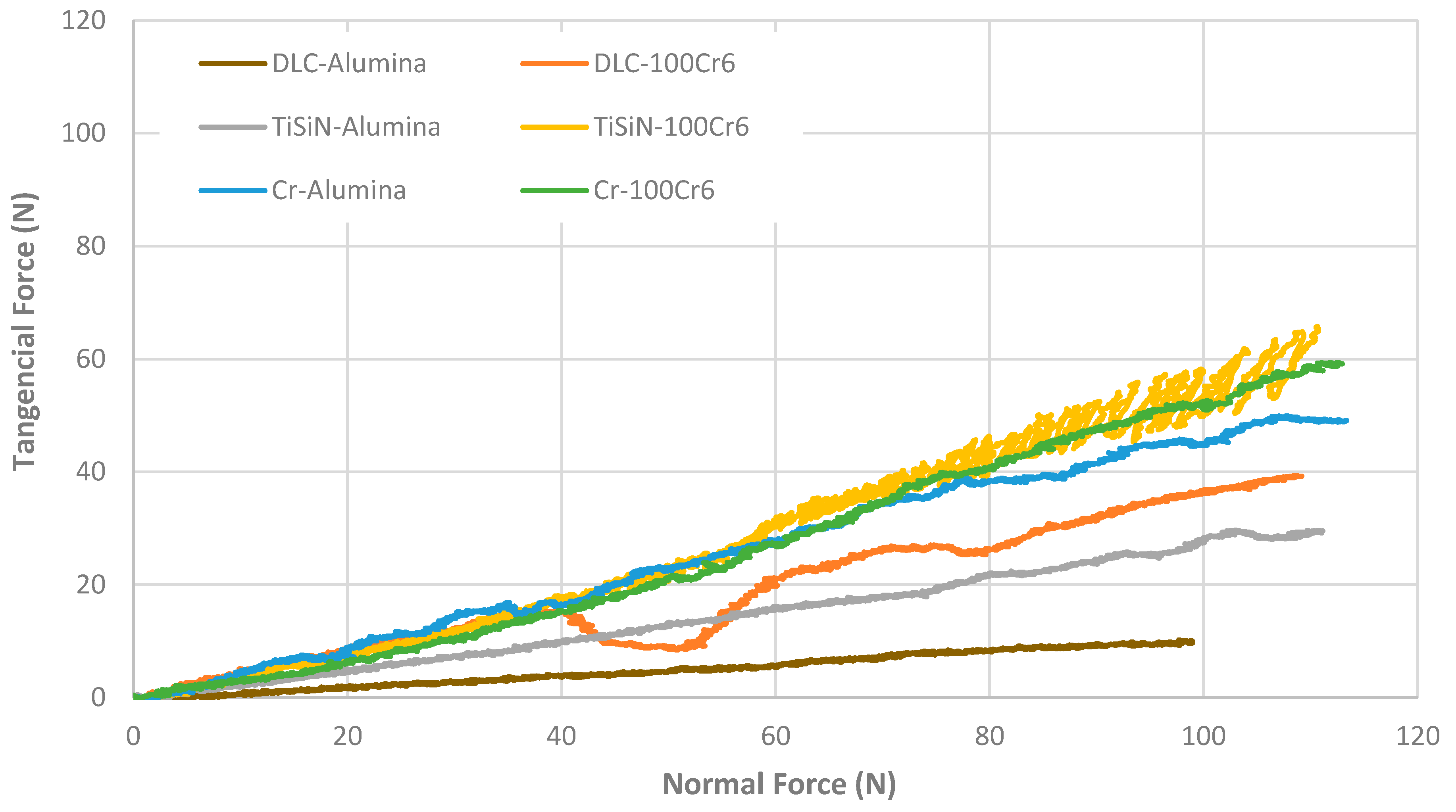
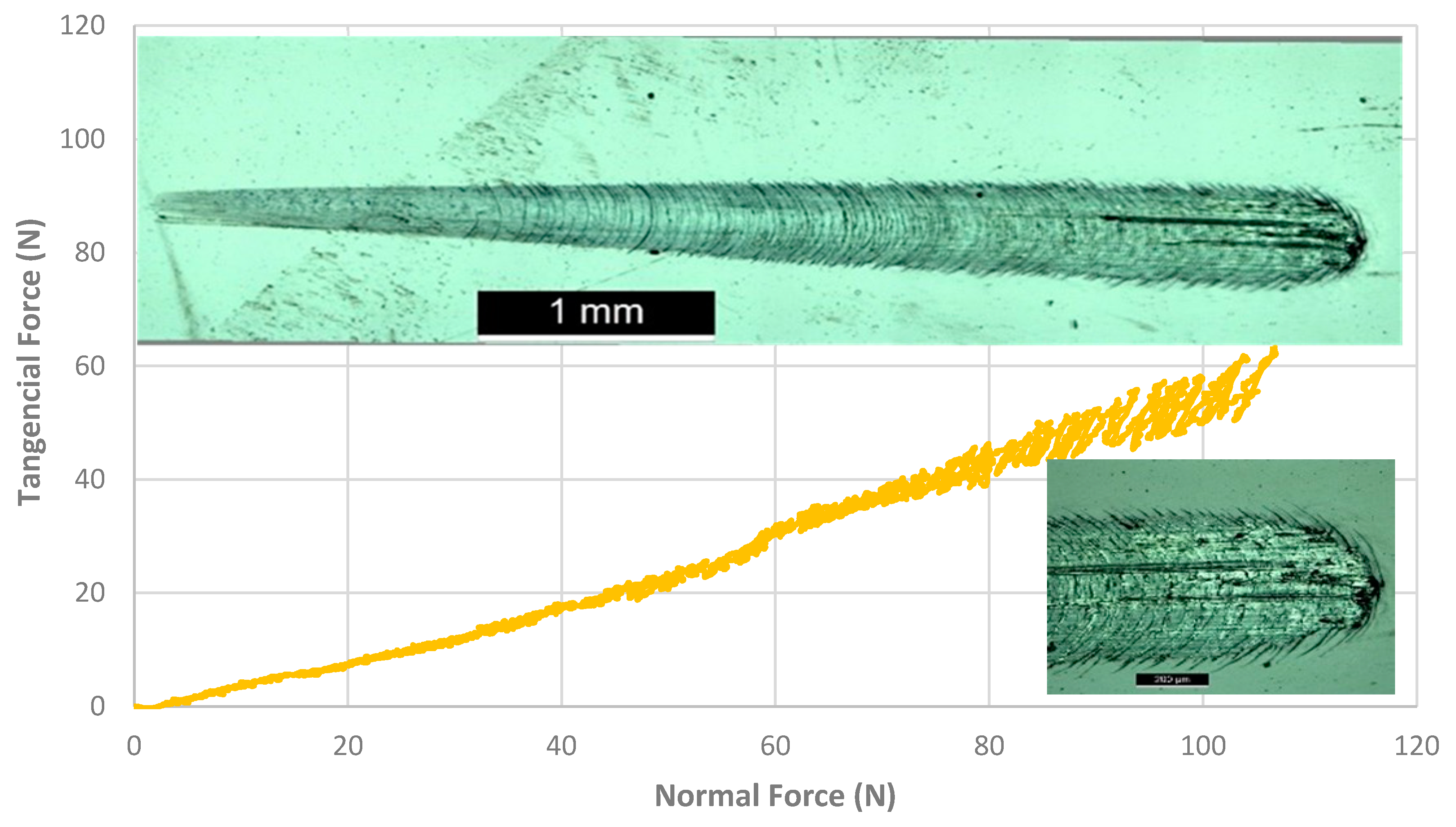
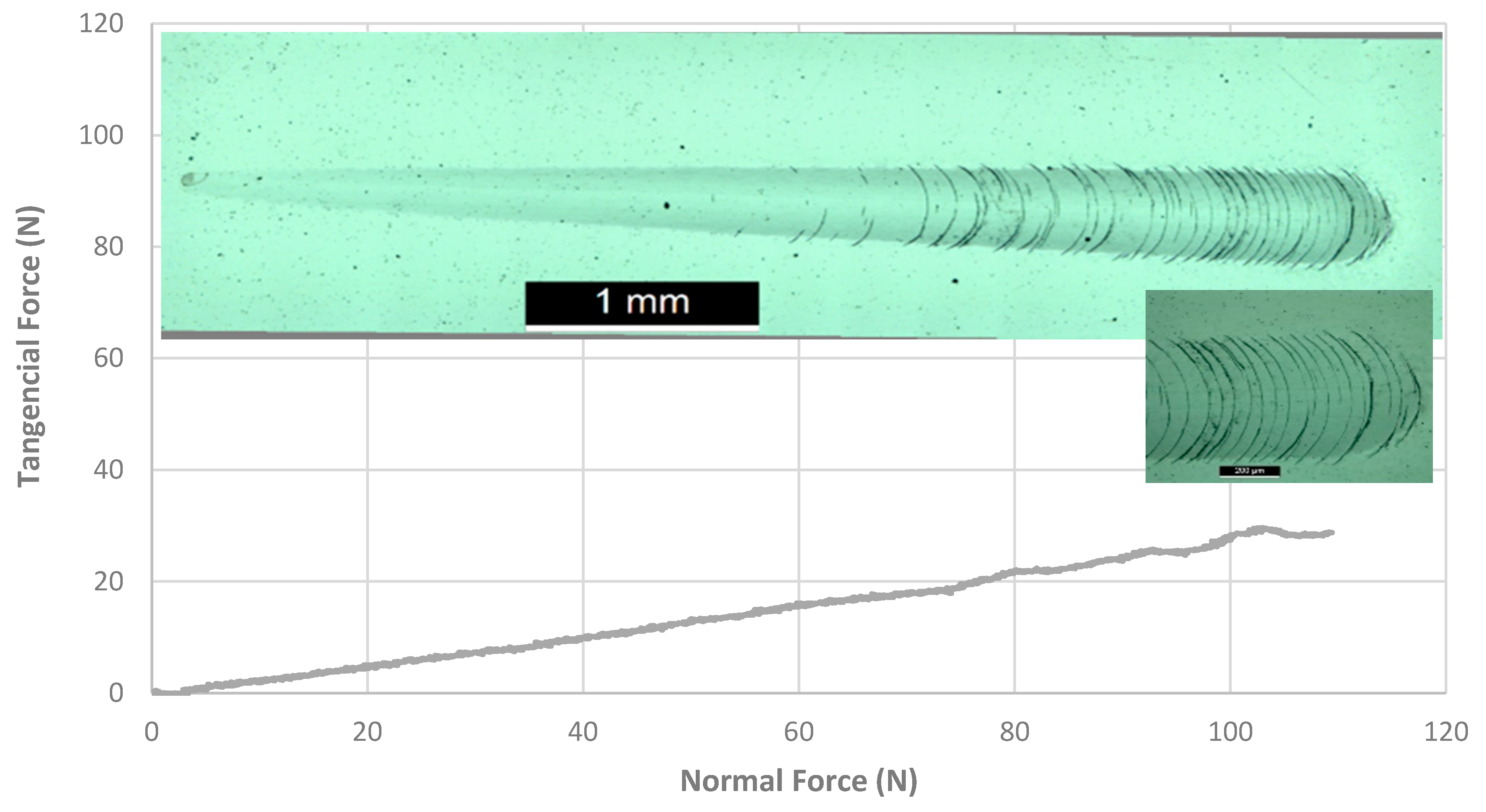
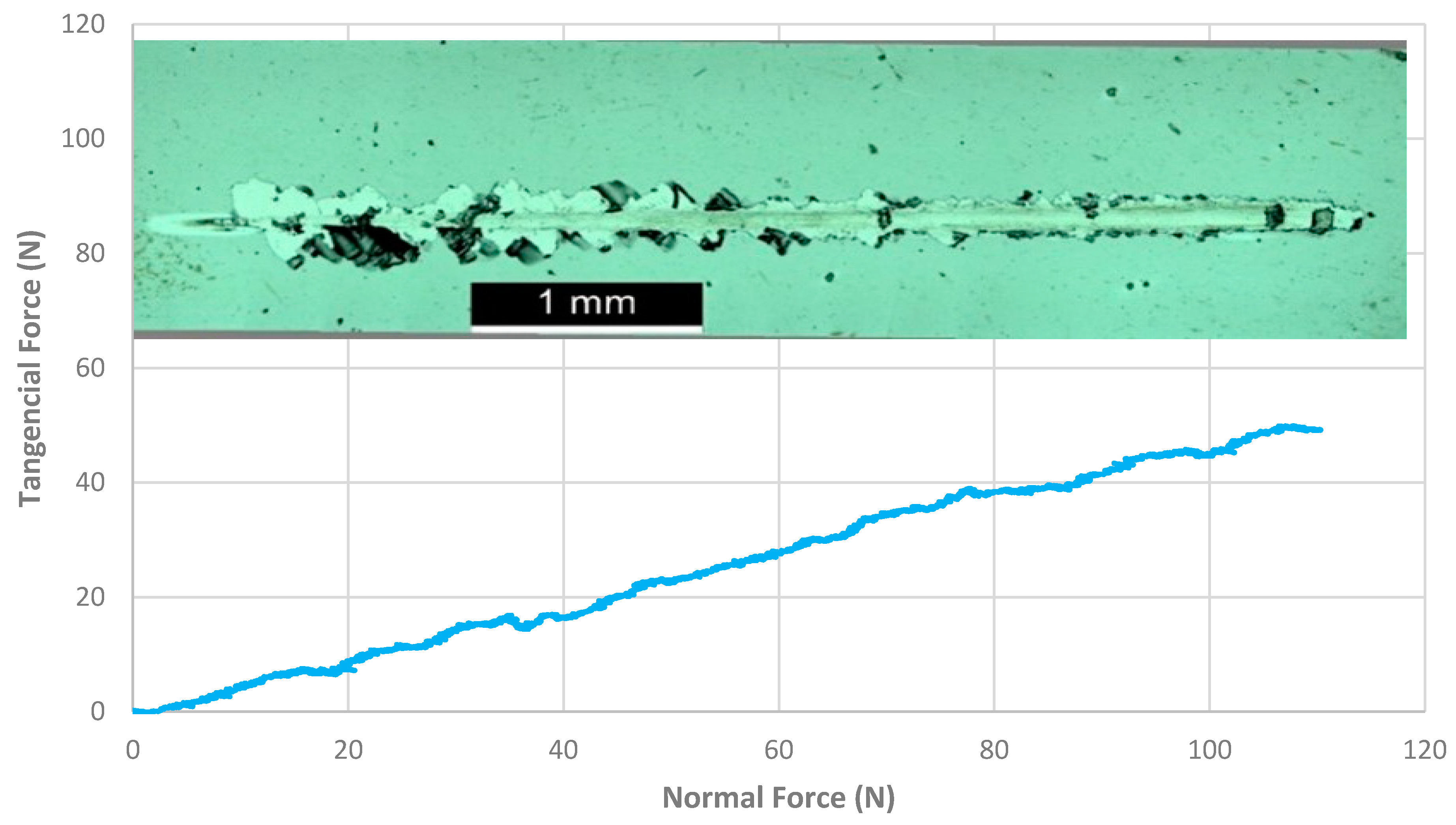
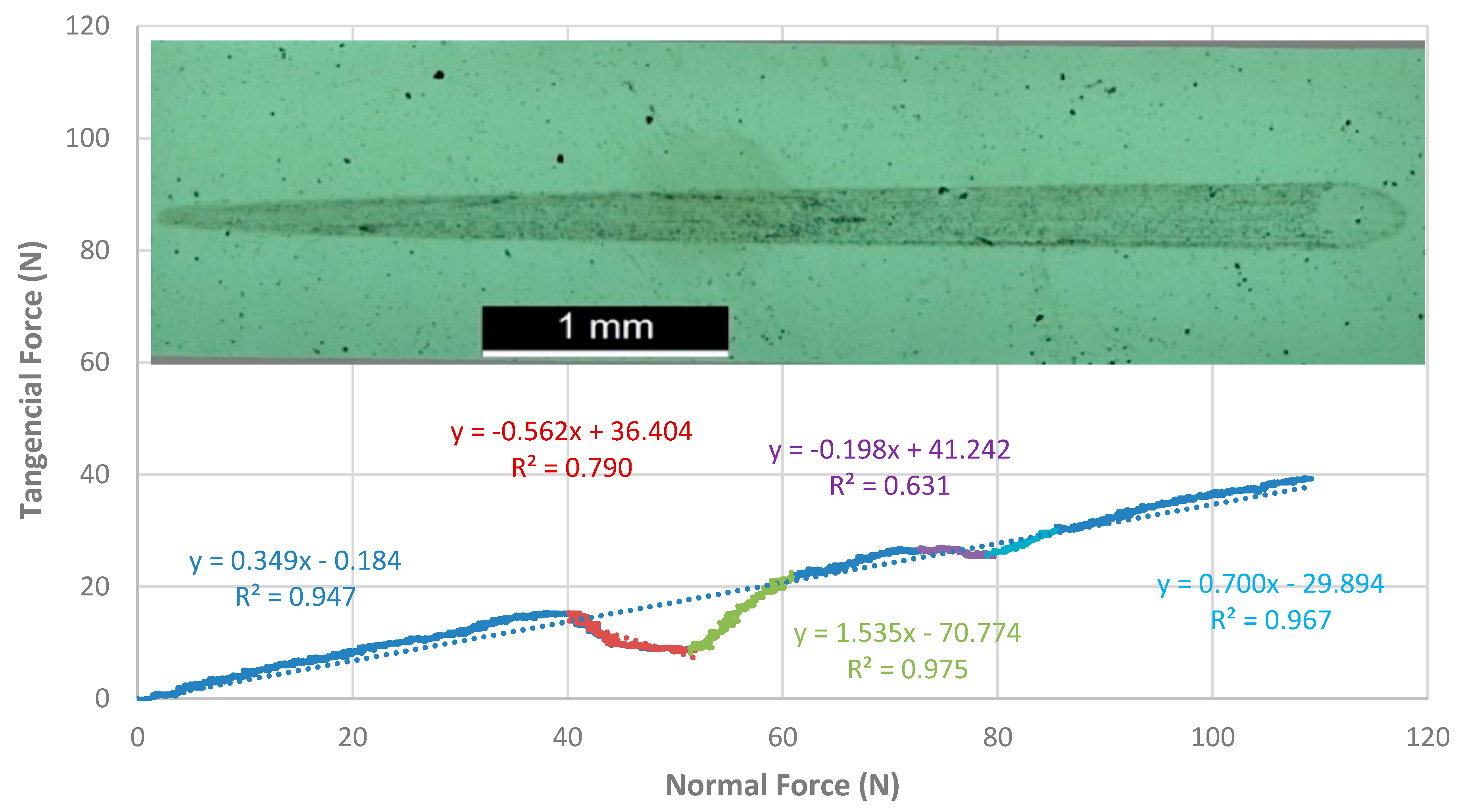
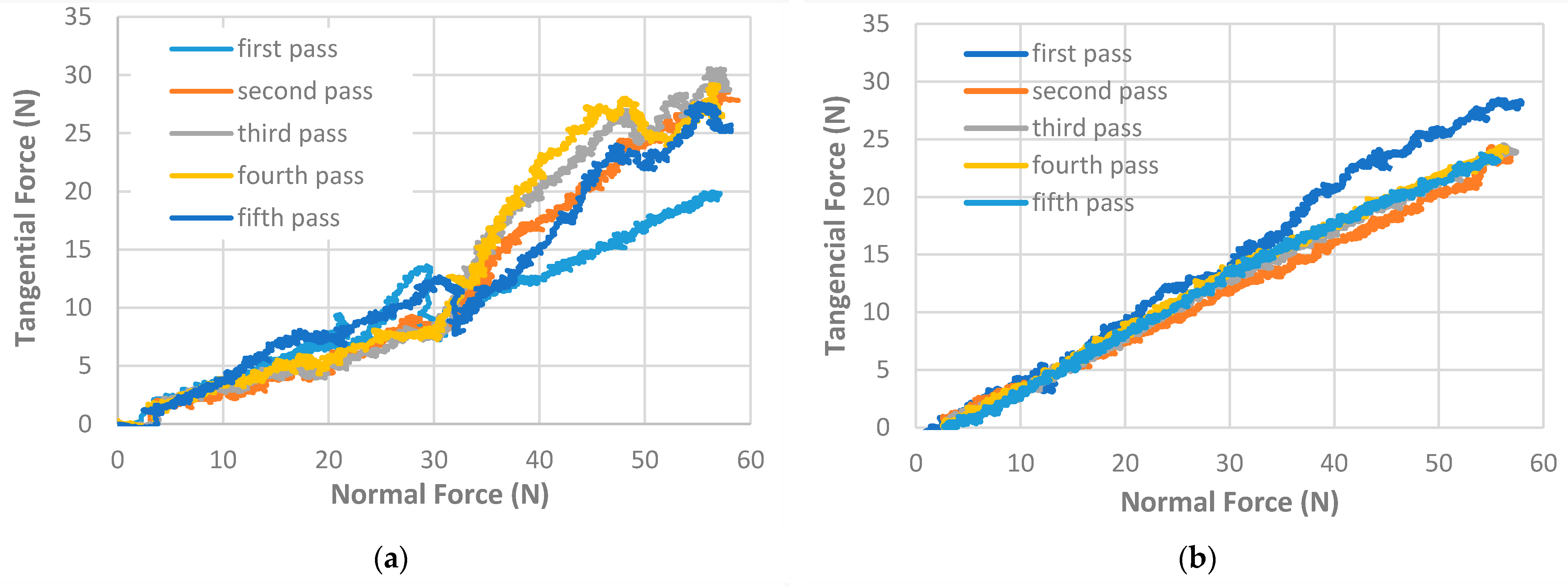
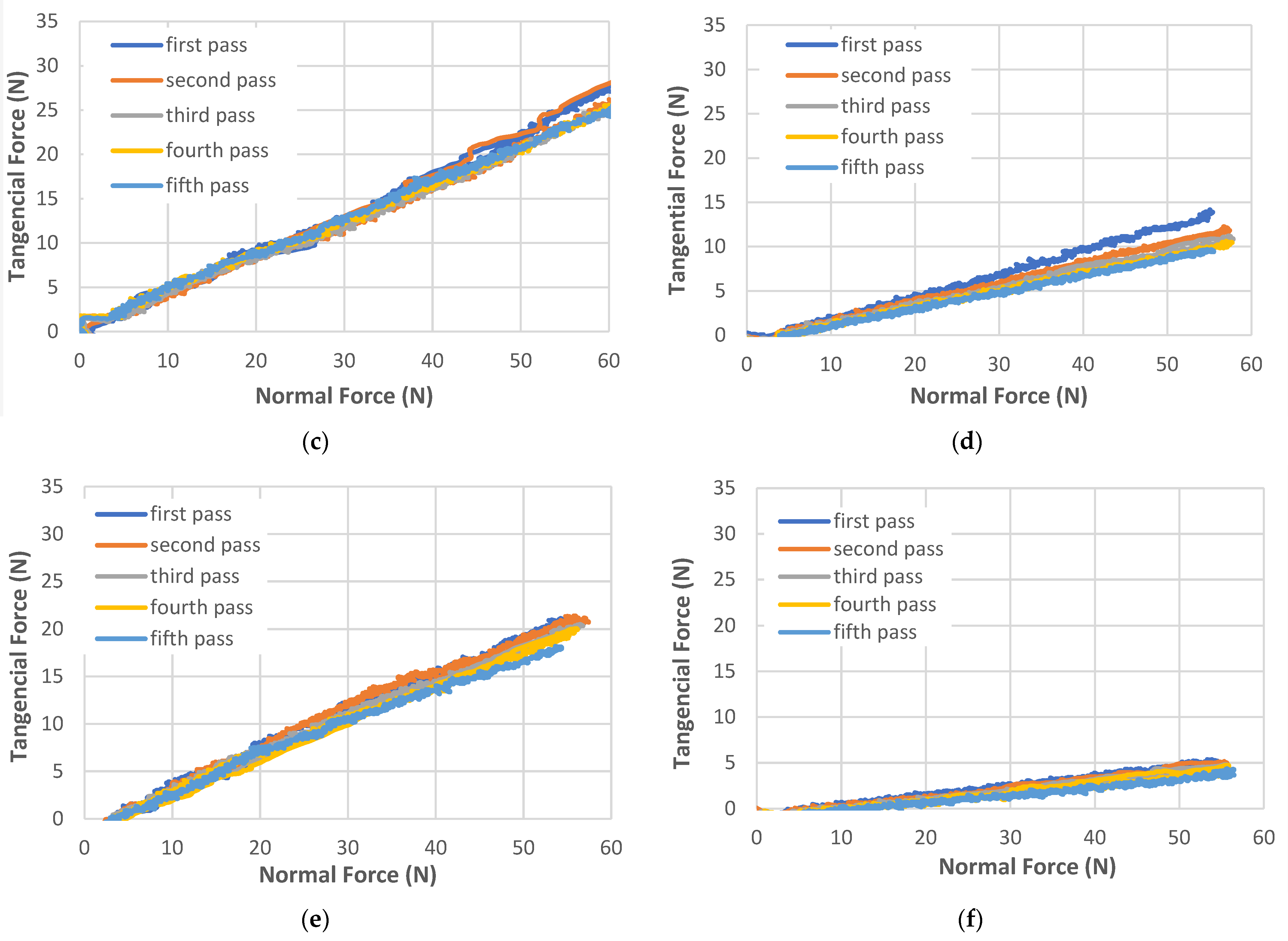

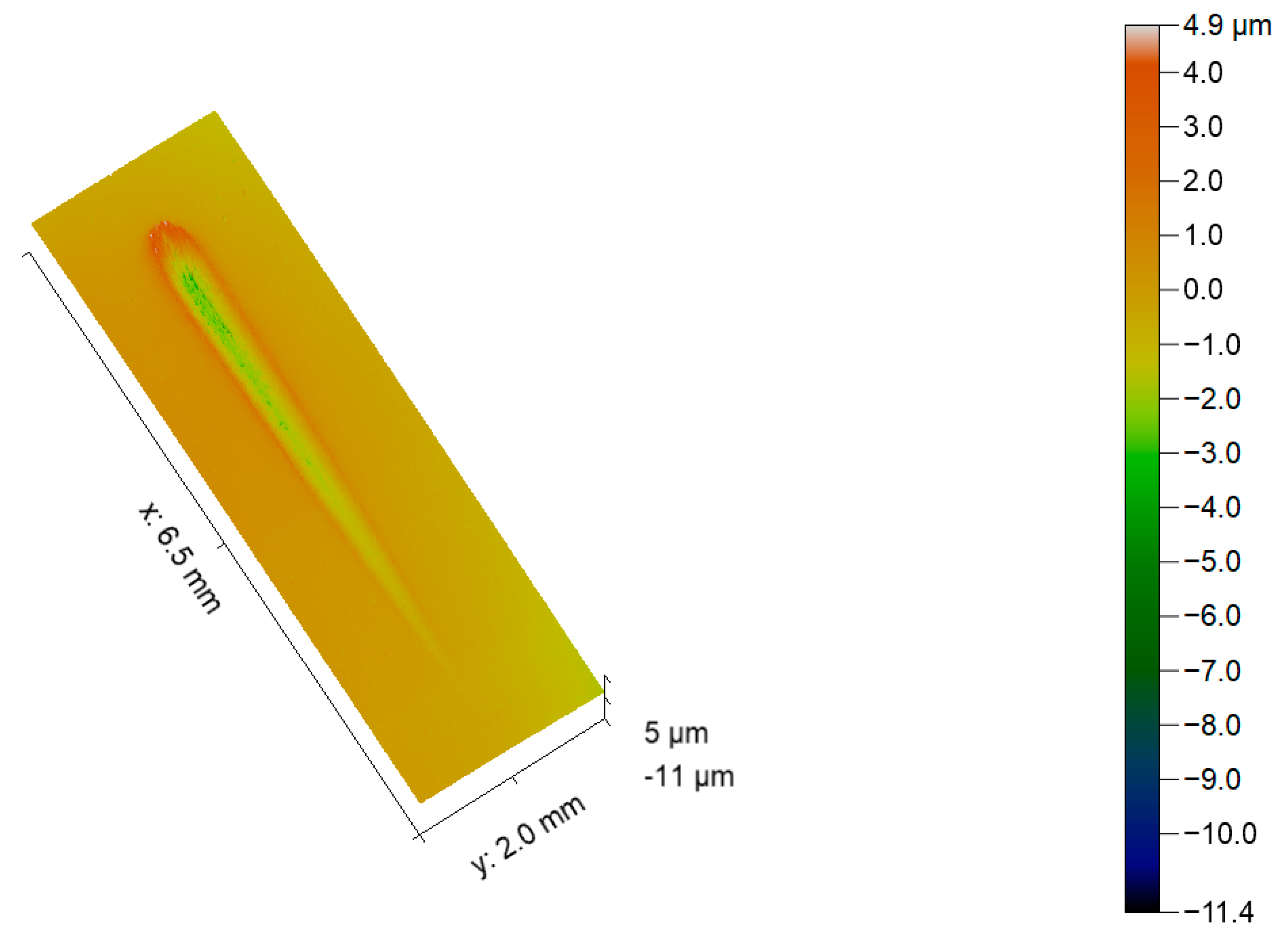
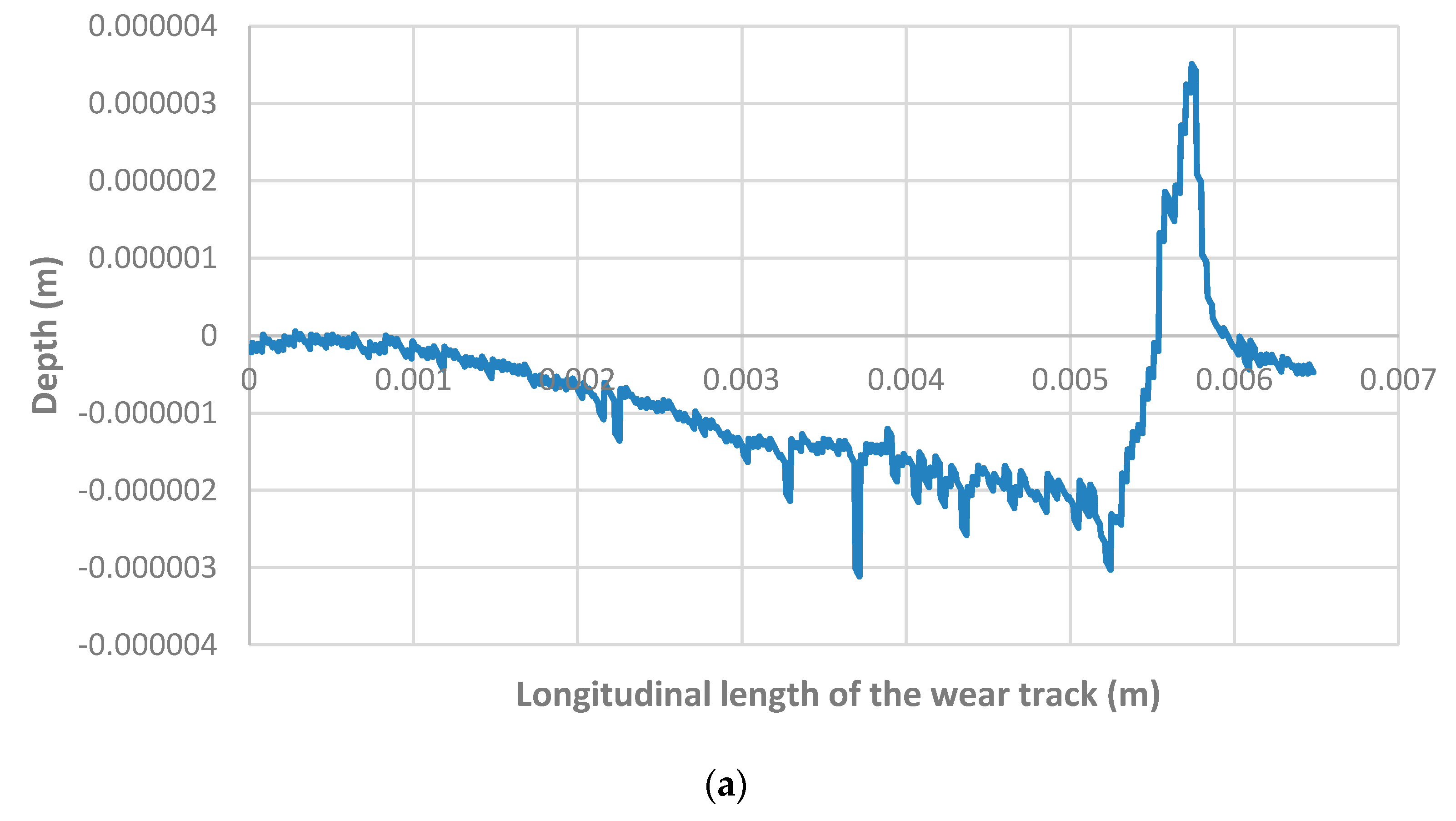
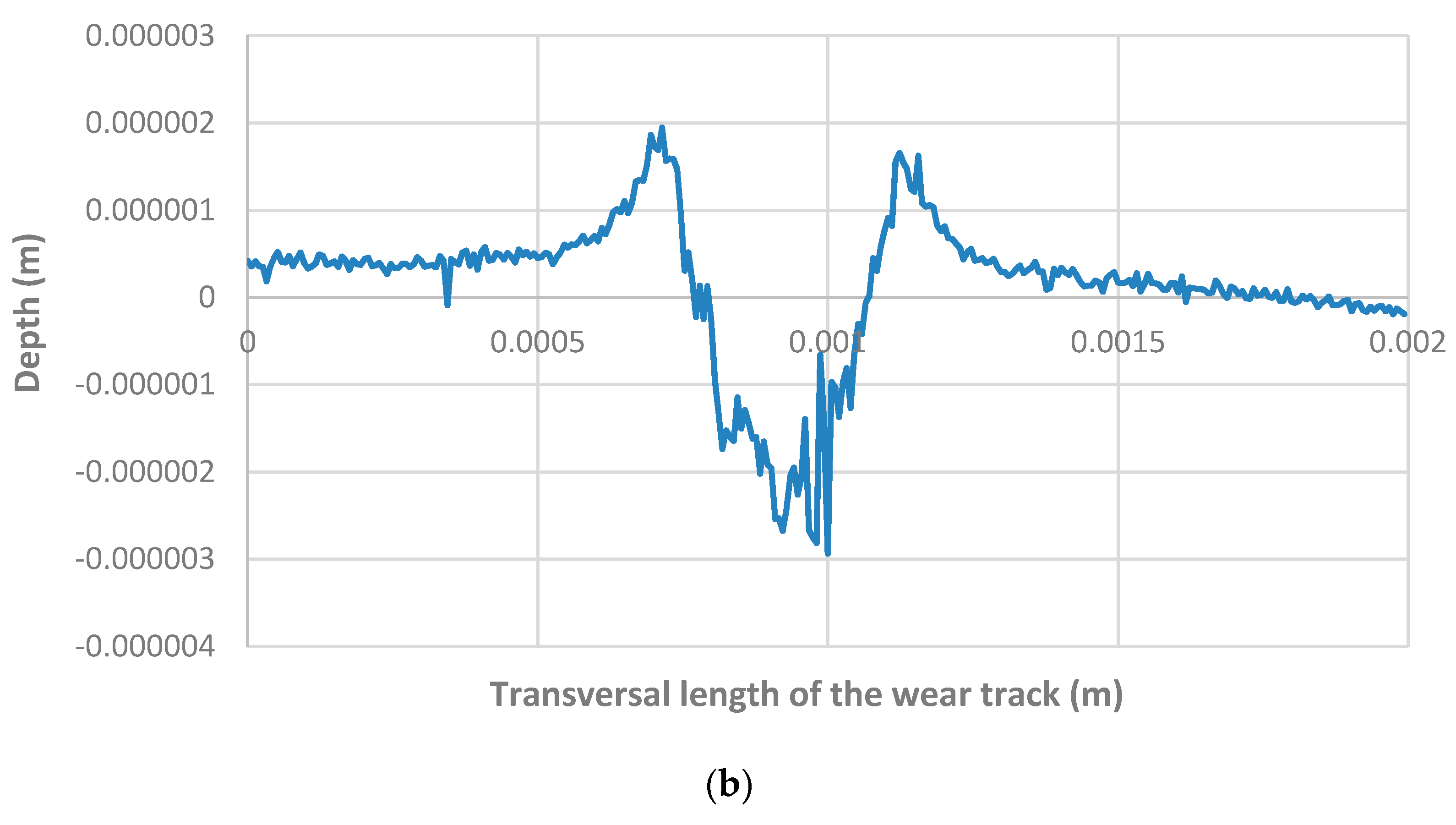
| Specimens | Designation | E [GPa] | Hardness [GPa] | Ra [μm] | Thickness [nm] |
|---|---|---|---|---|---|
| 1 | TiSiN1 | 250 | 33 | 0.1116 | 1000 |
| 2 | Cr1 | 285 | 18 | 0.1436 | 890 |
| 3 | DLC1 | 200 | 22 | 0.1103 | 800 |
| 4 | TiSiN2 | 230 | 23 | 0.1163 | 1000 |
| 5 | Cr2 | 285 | 18 | 0.1134 | 890 |
| 6 | DLC2 | 200 | 15 | 0.1179 | 800 |
| m [kg] | c [N·s/m] | k [N/m] | ωn [rad/s2] |
|---|---|---|---|
| 0.1453 | 0.1353 | 5042 | 186.28 |
| Tribological Pair | Counterbody | |||
|---|---|---|---|---|
| Thin Coatings | 100Cr6 | Al2O3 | ||
| µ ± STDEV | R2 | µ ± STDEV | R2 | |
| Cr | 0.18 ± 0.02 | 0.94 | 0.25 ± 0.04 | 0.86 |
| TiSiN | 0.23 ± 0.06 | 0.93 | 0.20 ± 0.02 | 0.96 |
| DLC | 0.32 ± 0.03 | 0.96 | 0.17 ± 0.02 | 0.97 |
| Tribological Pair | Counterbody | |
|---|---|---|
| Thin Coatings | 100Cr6 | Al2O3 |
| µ | ||
| Cr | 0.471 | 0.539 |
| TiSiN | 0.548 | 0.272 |
| DLC | 0.348 | 0.108 |
Publisher’s Note: MDPI stays neutral with regard to jurisdictional claims in published maps and institutional affiliations. |
© 2022 by the authors. Licensee MDPI, Basel, Switzerland. This article is an open access article distributed under the terms and conditions of the Creative Commons Attribution (CC BY) license (https://creativecommons.org/licenses/by/4.0/).
Share and Cite
Vilhena, L.; Ferreira, F.; Oliveira, J.C.; Ramalho, A. Rapid and Easy Assessment of Friction and Load-Bearing Capacity in Thin Coatings. Electronics 2022, 11, 296. https://doi.org/10.3390/electronics11030296
Vilhena L, Ferreira F, Oliveira JC, Ramalho A. Rapid and Easy Assessment of Friction and Load-Bearing Capacity in Thin Coatings. Electronics. 2022; 11(3):296. https://doi.org/10.3390/electronics11030296
Chicago/Turabian StyleVilhena, Luís, Fábio Ferreira, João Carlos Oliveira, and Amílcar Ramalho. 2022. "Rapid and Easy Assessment of Friction and Load-Bearing Capacity in Thin Coatings" Electronics 11, no. 3: 296. https://doi.org/10.3390/electronics11030296
APA StyleVilhena, L., Ferreira, F., Oliveira, J. C., & Ramalho, A. (2022). Rapid and Easy Assessment of Friction and Load-Bearing Capacity in Thin Coatings. Electronics, 11(3), 296. https://doi.org/10.3390/electronics11030296









